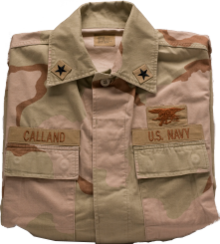Arid-environment camouflage uniform used by U.S. military from mid-1990s to early 2010s From Wikipedia, the free encyclopedia
The Desert Camouflage Uniform (DCU) is an arid-environment camouflage uniform that was used by the United States Armed Forces from the mid-1990s to the early 2010s. In terms of pattern and textile cut, it is identical to the U.S. military's Battle Dress Uniform (BDU) uniform, but features a three-color desert camouflage pattern of dark brown, pale olive green, and beige, as opposed to the four-color woodland pattern of the BDU. It replaced the previous Desert Battle Dress Uniform (DBDU) which featured a six-color "chocolate chip" pattern of beige, pale olive green, two tones of brown, and black and white rock spots. Although completely phased out of frontline use in the U.S. Armed Forces, some pieces and equipment printed in the DCU camouflage pattern are used in limited numbers such as MOPP suits and/or vests.
| Desert Camouflage Uniform | |
|---|---|
 A folded and buttoned U.S. Navy DCU blouse. | |
| Type | Military camouflage uniform |
| Place of origin | United States |
| Service history | |
| In service | 1991–2008 (U.S. Army)[1][2] 1993–2005 (U.S. Marine Corps) 1992–2011 (U.S. Air Force) 1993–2012 (U.S. Navy) 1993-present (SFOD-D) |
| Used by | See Users for other foreign military/law enforcement users |
| Wars | Gulf War (very limited use) Battle of Mogadishu War in Afghanistan Faylaka Island attack Iraq War |
| Production history | |
| Designer | Natick Laboratories |
| Manufacturer | Propper[3] |
| Produced | 1989–2012 |
| Variants | Close Combat Uniform[4][5] |

Designed in the mid-1980s by the U.S. Army's Natick Laboratories[6] and first issued in a very limited quantity in 1990, the DCU and its camouflage pattern, officially known as the Desert Camouflage Pattern and known colloquially as "coffee stain camouflage",[7] was developed to replace the six-color desert camouflage "chocolate-chip camouflage" uniform, which was deemed unsuitable for most desert combat theaters. As opposed to the original six-color DBDU, which was meant for a rockier and elevated desert battlefield that was often not encountered, the DCU was created primarily for a lower, more open, and less rocky desert battlefield space which became a common sight throughout the Persian Gulf War. As a replacement pattern, this meant a new arid region had to be utilized to test the effectiveness of the DCU. Desert soil samples from parts of the Middle East, namely Saudi Arabia, and Kuwait, were compared to similar terrain in the United States for evaluation. Color palettes were reused from 6-color desert.[6]
Though the DCU did exist during the Persian Gulf War, the vast majority of U.S. military personnel in Saudi Arabia, Kuwait, and Iraq wore the DBDU during the entirety of the war, with the exception of some select U.S. Army generals who were issued the DCU a month following the air campaign in Operation Desert Storm. Norman Schwarzkopf, then CENTCOM commander, and leader of U.S. forces during Desert Storm, was issued an M-65 field jacket as well as coat and trousers in the new DCU color pattern shortly before the war ended.[citation needed]
By 1992, the first wide scale batches of DCUs were issued first by the United States Army, and within a year to the United States Air Force, and replaced the majority of the DBDU by 1993, with the United States Navy and Marines replacing their older six-colored desert fatigues from 1993 through 1995.
First fielded in 1991, the DCU served as the U.S. Army's primary desert combat pattern from 1992 to 2004. In June 2004,[8][9] the Army unveiled a new pixel-style camouflage pattern called UCP (Universal Camouflage Pattern), to be used on the DCU's successor uniform, the Army Combat Uniform (ACU).
In fall 2003 and winter 2004, the "Close Combat Uniform" and "Combat Uniform"[10] were issued to U.S. Army soldiers in Stryker Brigade elements of the 2nd Infantry Division[11][12] and 25th Infantry Division, respectively, when they were deployed to Iraq.[13] In January 2003, development began with input from certain members of the 3rd SBCT, 2nd Infantry Division.[14] These uniforms featured additions such as shoulder pockets affixed with hook-and-loop "Velcro" fasteners as well as a redesigned collar and chest-worn rank insignia.[4] They were made by American Power Source, Inc.[10] and only saw brief usage as they were issued shortly before the introduction of the newer ACU in mid-to-late 2005.[4][5]
In mid-2005, the DCU and the BDU began slowly being discontinued within the U.S. Army. By 2007, most U.S. soldiers were wearing the ACU with both the DCU and BDU being fully replaced by early 2008.[15][2]
Following the Army, the United States Marine Corps began issuing the DCU from 1993 through 1995 and remained the Marine Corps standard arid combat uniform from 1993 to 2003. In January 2002, the U.S. Marine Corps became the first branch to replace both its BDUs and DCUs with the Marine Corps Combat Utility Uniform (MCCUU), completely replacing them by April 2005.[16]
Along with the Army, the Air Force began issuing the DCU in 1992 and remained its primary desert uniform until 2011. The U.S. Air Force officially replaced the BDU and DCU on 1 November 2011, with the Airman Battle Uniform (ABU),[17] though most airmen had been using the ABU for a couple years before that date.
The United States Navy issued the DCU from 1993 until 2010 when it was replaced by the arid variant of the Navy Working Uniform (NWU), known as the NWU Type II. The DCU was retired by the navy in late 2012.[18]
The DCU was introduced to the Coast Guard sometime in the 1990s. The DCU and BDU were formally retired by the USCG in 2012.[18]
Seamless Wikipedia browsing. On steroids.